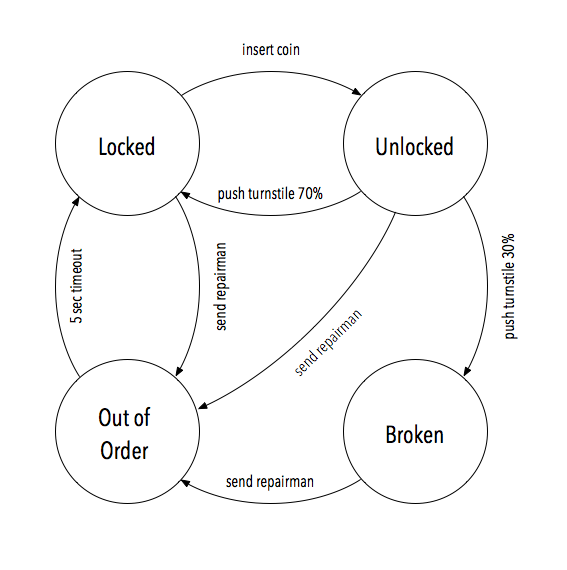An Objective-C implementation of the Finite State Machine pattern.
This library is a bit of a hodgepodge. My father, Ross Pink, has been using state machines for embedded systems programming in FORTH since he was taught the technique at Uni in the 70's. He swears by this one particular style of state machine and has used it very effectively to produce reliable electronic controllers throughout his career.
Ross taught me this particular style of state machine but I have had trouble trying to implement it in an object oriented fashion. I mentioned my dilemma to a friend, Matt Connolly, and after thinking about it for a while he proposed the current solution.
The key features of the method are
- A states entire code base is grouped in one section of code
- A state machines entire code base is contained in a single file (.h/.m file pair)
This is a bit different to most modern state machine techniques which group the state definitions into one table and the state transitions into another table. I prefer EIStateMachine's approach as the entirety of a states computation (All of the events it can receive and the reasons to transition to another state) are all presented in the one section of code (usually on one page). I find it easier to reason about the code in this format.
The fact that the library uses Objective-C's forwarding mechanism is simply a means to provide the qualities listed above.
With this library you end up creating a state machine object of your own design. This object responds to messages based on which state it is currently in. You also define the behaviour of each of the states. The state machine can respond to state-independent messages. The decision to change from one state to another is built into each of the states. The states can run tasks when they are entered for the first time. Each machine includes a timer object which can be used for timeout functionality. The machine provides a set of notifications for when states change.
In order to roll your own state machine you need to provide the following
- Create your machine class as a subclass of EIStateMachine
- For each possible state create a subclass of EIState that conforms to the EIStateProtocol.
Usually you will put both the EIStateMachine subclass and all of the EIState classes into the one, MyStateMachine.h/.m file pair. From your controller object in your project you then create an instance of MyStateMachine and proceed to send it messages from the rest of your application.
This is a rough template of the header file for your state machine
#import <Foundation/Foundation.h>
#import "EIStateMachine.h"
@class State1;
@class State2;
@interface MyStateMachine : EIStateMachine
@property (nonatomic, readonly) State1 *state1State;
@property (nonatomic, readonly) State2 *state2State;
@property (readwrite) NSString *otherStateIndependentProperties;
-(void) otherStateIndependentMethods:(id)aValue;
@end
@interface State1 : EIState <EIStateProtocol>
-(void) stateSpecificMethod:(NSString *)aString;
@end
@interface State2 : EIState <EIStateProtocol>
@end
Note that each of the states needs to be set as a property of the state machine. You can create state independent properties and methods (these will be responded to and accessible from all states). States can declare their own methods and properties, these will only be accessible from within the specific state.
There are some hoops that must be jumped through when accessing the state independent variables and methods from within a state. When you initialise a state within your Machines init method you need to provide it with a reference back to the machine itself. This is then accessible via the machine variable for each state. Now you can use this to reach the methods that are builtin to the EIStateMachine class such as
[self.machine setNextState:aState];
[self.machine changeState];
Unfortunately this doesn't allow you to access the variable and methods that you defined in your own subclass of the EIStateMachine class. In order to reach these items you need to first cast the machine object to your own class.
[(MyStateMachine *)self.machine otherStateIndependentMethods:aValue];
As a way of demonstrating the library I implemented an extended version of the turnstile example from wikipedia, http://en.wikipedia.org/wiki/Finite-state_machine.
The basic turnstile state machine has two states, Locked and Unlocked. Inserting a coin when Locked transitions to the Unlocked state. Pushing on the turnstile when Unlocked transitions to the Locked state. Any other combination of event and state yields no action.
I added to this machine states for when the turnstile is Brocken and Out Of Order e.g. being repaired. When you push on the turnstile there is a 30% chance that it will break. At any time you can send a repairman to service the turnstile which will place it in the Out Of Order state until he has finished his work (a 5 second timer function). The diagram for the state machine is shown below.
